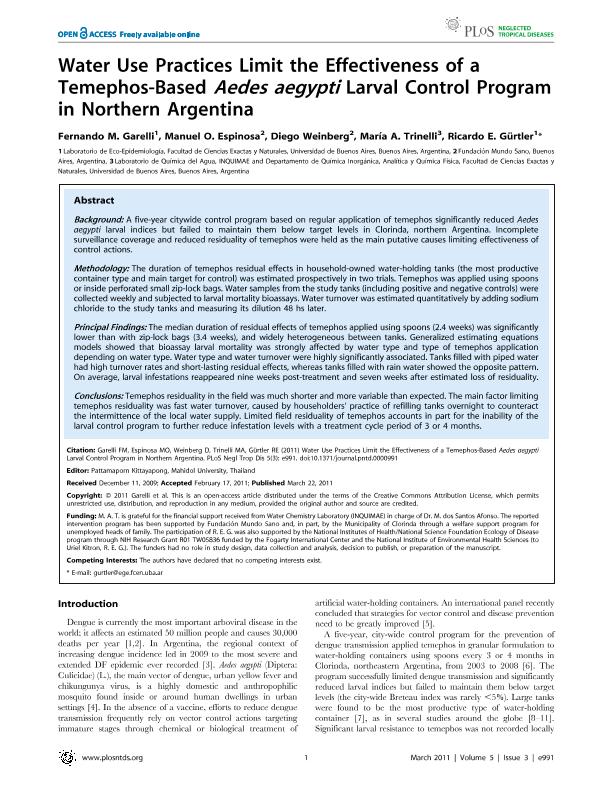Artículo
Water use practices limit the effectiveness of a temephos-based Aedes aegypti larval control program in Northern Argentina
Garelli, Fernando Miguel ; Espinosa, Manuel O.; Weinberg, Diego; Trinelli, María Alcira
; Espinosa, Manuel O.; Weinberg, Diego; Trinelli, María Alcira ; Gurtler, Ricardo Esteban
; Gurtler, Ricardo Esteban
 ; Espinosa, Manuel O.; Weinberg, Diego; Trinelli, María Alcira
; Espinosa, Manuel O.; Weinberg, Diego; Trinelli, María Alcira ; Gurtler, Ricardo Esteban
; Gurtler, Ricardo Esteban
Fecha de publicación:
05/2011
Editorial:
Public Library of Science
Revista:
Neglected Tropical Diseases
ISSN:
1935-2735
Idioma:
Inglés
Tipo de recurso:
Artículo publicado
Clasificación temática:
Resumen
A five-year citywide control program based on regular application of temephos significantly reduced Aedes aegypti larval indices but failed to maintain them below target levels in Clorinda, northern Argentina. Incomplete surveillance coverage and reduced residuality of temephos were held as the main putative causes limiting effectiveness of control actions. The duration of temephos residual effects in household-owned water-holding tanks (the most productive container type and main target for control) was estimated prospectively in two trials. Temephos was applied using spoons or inside perforated small zip-lock bags. Water samples from the study tanks (including positive and negative controls) were collected weekly and subjected to larval mortality bioassays. Water turnover was estimated quantitatively by adding sodium chloride to the study tanks and measuring its dilution 48 hs later. The median duration of residual effects of temephos applied using spoons (2.4 weeks) was significantly lower than with zip-lock bags (3.4 weeks), and widely heterogeneous between tanks. Generalized estimating equations models showed that bioassay larval mortality was strongly affected by water type and type of temephos application depending on water type. Water type and water turnover were highly significantly associated. Tanks filled with piped water had high turnover rates and short-lasting residual effects, whereas tanks filled with rain water showed the opposite pattern. On average, larval infestations reappeared nine weeks post-treatment and seven weeks after estimated loss of residuality. Temephos residuality in the field was much shorter and more variable than expected. The main factor limiting temephos residuality was fast water turnover, caused by householders' practice of refilling tanks overnight to counteract the intermittence of the local water supply. Limited field residuality of temephos accounts in part for the inability of the larval control program to further reduce infestation levels with a treatment cycle period of 3 or 4 months.
Palabras clave:
Aedes Aegypti
Archivos asociados
Licencia
Identificadores
Colecciones
Articulos(IEGEBA)
Articulos de INSTITUTO DE ECOLOGIA, GENETICA Y EVOLUCION DE BS. AS
Articulos de INSTITUTO DE ECOLOGIA, GENETICA Y EVOLUCION DE BS. AS
Citación
Garelli, Fernando Miguel; Espinosa, Manuel O.; Weinberg, Diego; Trinelli, María Alcira; Gurtler, Ricardo Esteban; Water use practices limit the effectiveness of a temephos-based Aedes aegypti larval control program in Northern Argentina; Public Library of Science; Neglected Tropical Diseases; 5; 3; 5-2011; 1-9; e991
Compartir
Altmétricas



